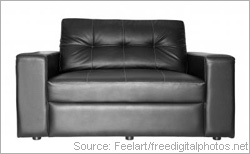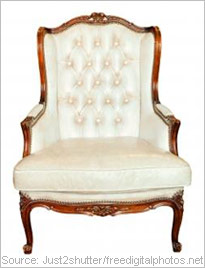
Leather furniture is durable, long-lasting, luxurious and
comfortable. It is also expensive, so you'll want to ensure it stays in
beautiful condition for as long as possible. Proper cleaning methods and stain
removal are essential to keep your leather furniture looking like new for years
to come.
Before you begin
Before you start cleaning your leather
furniture, it's important to know what type of leather it's made from. Some
types are not tolerant of water whatsoever, and require special leather cleaner
or the help of professionals. This information can usually be found on your
furniture tags or any written instructions you received with its purchase. If
not, contact the retailer for more information. Most leather furniture is made
from top-coat protected leather, which can be cleaned with water and mild soap,
as explained in this guide.
What you'll need:
- Vacuum with soft brush attachment
- Distilled water (the chlorine in tap water can be harmful to the leather's
surface)
- Mild liquid soap
- Several clean, soft cloth rags
- Water-based leather protector/conditioner
Cleaning the furniture
- Begin by vacuuming the piece of furniture to suck up any loose dirt, dust,
or debris. Be sure to use the soft brush attachment to avoid scratching the
leather, and keep it on a low setting to avoid dents.
- Put a few drops of soap into about a quart of water, and mix until it
becomes sudsy. Dip one of the rags into the water and wring out.
- Test the cloth on a small area of the furniture, preferably one that is
normally out of view to ensure it doesn't harm the leather's surface.
- Wipe the surface gently, one section at a time.
- Dip another rag into plain water, and wipe off the soap mixture.
- Dry each damp section of the furniture with a third, dry cloth.
- Use a fourth cloth to gently buff the furniture and increase shine.
- Apply leather conditioner to the furniture, following instructions on the
bottle.
Stain removal
Depending on the type of stain, there are a
variety of DIY home methods for treating spills on your luxurious leather
furniture. Always test any method on a small, inconspicuous area of the
furniture, and make sure the suggested solutions are permissible for use on the
type of leather piece you have.
- Dark stains (mud, food, blood): Create a paste that's one part cream
of tartar and one part lemon juice. Rub the paste into the stain and allow the
mixture to sit for about 10 minutes. Remove the paste with a soap and distilled
water soaked cloth (as described above), wipe dry, and buff.
- Water stains: Wipe up water immediately after it's spilled with a
soft cloth. If a stain forms from spilled water that's dried on the furniture,
you will have to blend the stain with the surrounding area. Dampen a cloth with
plain, distilled water and wipe outward from the center of the stain. Be gentle,
and use a dry cloth to blend the water into the outer edges of the stain.
- Grease stains: Eating oily or greasy foods on your leather furniture
can make for a mess-and an unattractive stain left behind. Wipe up as much of
the grease as you can, and shake a layer of cornstarch onto the surface of the
stain. Allow it to sit for 10 minutes, and vacuum the particles, using your soft
brush attachment.
Other tips
 Nourish the leather. Restore your leather's luster
by mixing two parts linseed oil with one part white vinegar and shaking
thoroughly. Dampen a soft cloth with the solution and gently wipe the surface of
your leather furniture circular motion. Allow the mixture sit for 10 minutes and
then buff with a dry cloth until it shines.
Nourish the leather. Restore your leather's luster
by mixing two parts linseed oil with one part white vinegar and shaking
thoroughly. Dampen a soft cloth with the solution and gently wipe the surface of
your leather furniture circular motion. Allow the mixture sit for 10 minutes and
then buff with a dry cloth until it shines.
- Avoid abrasive chemicals. Harsh cleaning products such as
ammonia-based cleaners, varnish, and bleach should be avoided on or near your
leather furniture. They can cause damage or discoloration. You should also never
use baby wipes or other alkaline products, oils, or anything containing wax or
silicone.
- Vacuum furniture regularly. Keep your leather furniture looking great
by vacuuming frequently to remove dust particles and other debris. This helps
your leather breathe and eliminates dirt and other film that can cause unsightly
stains.
- When in doubt, call the professionals. If you have an especially
difficult stain you are unsure of how to remove, or you have a question about
the type of leather furniture you have and the proper way to clean it, don't
hesitate to call a professional leather cleaner. They can help you determine the
best way to remove any stain for the type of leather furniture you own while
avoiding further damage to your furniture.